
The ferns are a group of vascular plants that reproduce via spores and have neither seeds nor flowers. They differ from mosses by being vascular, i.e., having specialized tissues that conduct water and nutrients and in having life cycles in which the branched sporophyte is the dominant phase.

Hydrangea, commonly named the hortensia, is a genus of more than 70 species of flowering plants native to Asia and the Americas. By far the greatest species diversity is in eastern Asia, notably China, Korea, and Japan. Most are shrubs 1–3 m tall, but some are small trees, and others lianas reaching up to 30 m (100 ft) by climbing up trees. They can be either deciduous or evergreen, though the widely cultivated temperate species are all deciduous.
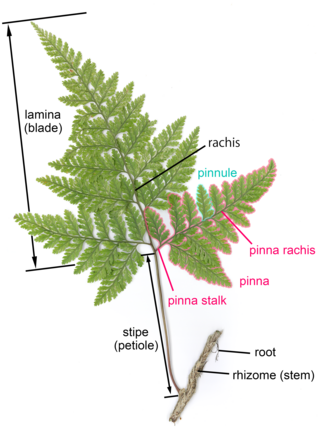
A frond is a large, divided leaf. In both common usage and botanical nomenclature, the leaves of ferns are referred to as fronds and some botanists restrict the term to this group. Other botanists allow the term frond to also apply to the large leaves of cycads, as well as palms (Arecaceae) and various other flowering plants, such as mimosa or sumac. "Frond" is commonly used to identify a large, compound leaf, but if the term is used botanically to refer to the leaves of ferns and algae it may be applied to smaller and undivided leaves.

Marattiaceae is the only family of extant (living) ferns in the order Marattiales. In the Pteridophyte Phylogeny Group classification of 2016, Marattiales is the only order in the subclass Marattiidae. The family has six genera and about 110 species. Many are different in appearance from other ferns, having large fronds and fleshy rootstocks.

Matteuccia is a genus of ferns with one species: Matteuccia struthiopteris. The species epithet struthiopteris comes from Ancient Greek words στρουθίων (strouthíōn) "ostrich" and πτερίς (pterís) "fern".

The order Cyatheales, which includes most tree ferns, is a taxonomic order of the fern class, Polypodiopsida. No clear morphological features characterize all of the Cyatheales, but DNA sequence data indicate the order is monophyletic. Some species in the Cyatheales have tree-like growth forms from a vertical rhizome, others have shorter or horizontal expanding rhizomes.
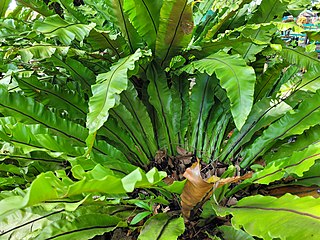
Asplenium nidus is an epiphytic species of fern in the family Aspleniaceae, native to tropical southeastern Asia, eastern Australia, Hawaii, Polynesia, Christmas Island, India, and eastern Africa. It is known by the common names bird's-nest fern or simply nest fern.
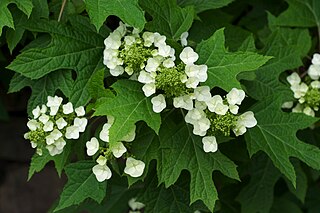
Hydrangea quercifolia, commonly known as oakleaf hydrangea or oak-leaved hydrangea, is a species of flowering plant in the family Hydrangeaceae. It is native to the southeastern United States, in woodland habitats from North Carolina west to Tennessee, and south to Florida and Louisiana. A deciduous shrub with white showy flower heads, it is grown as a garden plant, with numerous cultivars available commercially.

Onoclea sensibilis, the sensitive fern, also known as the bead fern, is a coarse-textured, medium to large-sized deciduous perennial fern. The name comes from its sensitivity to frost, the fronds dying quickly when first touched by it. It is sometimes treated as the only species in Onoclea, but some authors do not consider the genus monotypic.

Alsophila dregei, synonym Cyathea dregei, is a widespread species of tree fern in southern Africa.

Ceratopteris thalictroides is a fern species belonging to the genus Ceratopteris, one of only two genera of the subfamily Parkerioideae of the family Pteridaceae.

Aglaomorpha fortunei, commonly known as gu-sui-bu, is a species of basket fern of the family Polypodiaceae. The plant is native to Eastern Asia, including eastern China.

Carcar City, officially the City of Carcar, is a 5th class component city in the province of Cebu, Philippines. According to the 2020 census, it has a population of 136,453 people.

Ficus montana is a species of subtropical climbing fig plant. Leaves are 3 to 5 inches long. The leaves are shaped like oak leaves which gives its common name. It is grown as a houseplant, in offices and in shopping malls. It is slow growing. It is often confused with the tiny F. pumila quercifolia, which is a vining species that creeps on the surface of soil. The Latin specific epithet montana refers to mountains or coming from mountains.
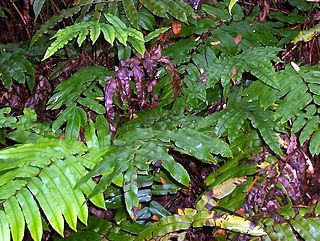
Parablechnum wattsii, synonym Blechnum wattsii, is a common terrestrial fern growing in rainforest and open forest. It is often seen near creeks in much of south eastern Australia, including Victoria, Tasmania, South Australia, New South Wales and Queensland. The specific epithet wattsii honours William Walter Watts (1856-1920). Watts was considered an authority on mosses and ferns and has more than 30 species named for him. Common names by which the species may be called are hard water fern - from its stiff leathery fronds, leech fern - as forest workers often encounter leaches while working in clusters of these ferns, hard hill fern - from the fern's habit and habitat, and red cabbage fern - from the bronze-pink colour of the young fronds resembling cooked red cabbage.
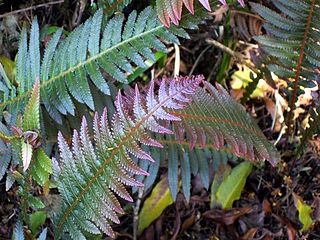
Doodia aspera, commonly known as prickly rasp fern, is a widespread and common plant, growing in eastern Australia. Often seen in rainforest margins or eucalyptus forest in Victoria, New South Wales and Queensland, it is a terrestrial fern with reddish new growth.

Aglaomorpha is a genus of ferns in the subfamily Drynarioideae of the family Polypodiaceae. The Pteridophyte Phylogeny Group classification of 2016 uses this genus name, while other sources use Drynaria to include Aglaomorpha. Species are commonly known as basket ferns. As circumscribed in PPG I, the genus contains around 50 species.

Aglaomorpha rigidula is a species of tropical fern in genus Aglaomorpha widely distributed throughout Southeast Asia, from Southwest China to Queensland and New South Wales in Australia. Growing as an epiphyte or lithophyte, its green fronds are up to 1.22 metres in length. This fern develops two types of fronds, some of which near the base of the plant are shorter, sterile, and rust-colored which form a basket-like shape that trap moisture and organic components that nourish it. Especially in colder weather, this basket acts as prime habitat for animals such as the Amethystine python.

Aglaomorpha bonii is a species of subtropical fern native to Southeast Asia. Growing as an epiphyte or lithophyte, its rhizome is covered in dry, paper-like fronds while the larger fronds are fertile and bear spores. This fern has long been used in traditional medicine in Vietnam to treat a variety of ailments, and in scientific research, compounds from the plant have demonstrated antibacterial and antioxidant properties.

Aglaomorpha willdenowii is a species of subtropical fern native to the islands of Comoros, Madagascar, and Mauritius. Drynarioid ferns are largely native to Asia and Oceania, but A. willdenowii is the only species of fern in the genus native to Madagascar. Like other Aglaomorpha, its caudex is covered in dry, scale-like sterile fronds and fine hairs, while the larger green fronds are the fertile ones bearing spores.






















